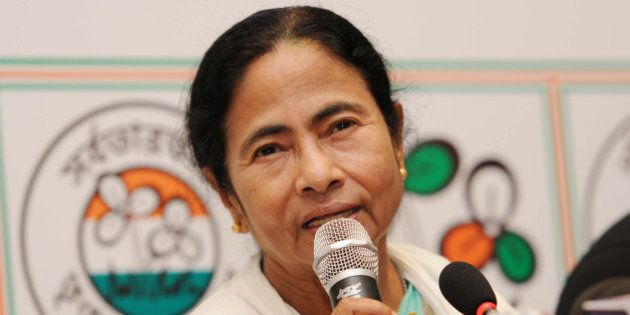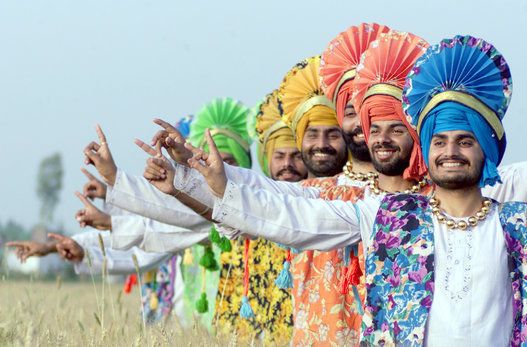
Among the many remarkable things that Mamata Banerjee accomplished in her magnificent election win in West Bengal, one was exorcising the 'curse of Kolkata'. This phenomenon, so far noted but not christened as such, is the defiance that voters in Calcutta have generally shown the ruling party in Bengal over the past 40 years. With a few exceptions, this has held true in elections for nearly four decades.
Banerjee's party won all 11 seats in the city this time. It managed the same feat in 2011 as well, but that was an exceptional election, when the state voted out the Left after 34 years in power.
For nearly every election before that all the way till 1977, Kolkata cocked a snook at the party that was favoured by the people of West Bengal. In 2011, due to a delimitation exercise, the number of assembly constituencies that comprise Kolkata came down to 11. Prior to that, the city sent 21 MLAs to the assembly building.

TMC supporters celebrate the party's victory.
Prior to 2016, out of 8 elections since 1977, there have only been three exceptions to the trend. The first was in 1977 itself, the next was in 1991, and the third was in 2011. Two of them were elections where the long rule of a party was being rejected across the state--the Congress in 1977 and the Left in 2011.
The Left Front came to power for the first of its seven consecutive terms in 1977. That year, the Left Front secured 16 seats out of 21, their best performance ever in Kolkata. The five other seats went to the Jan Sangh, the predecessor of the BJP. You could argue, then, that when the BJP claims this is their best performance in Bengal or that they are making inroads in the state, it is only a partial truth. The Jan Sangh had a presence before them, and indeed, Shyama Prasad Mookerjee founded the party in Kolkata.
In 1982, the first election that the Left Front faced as an incumbent government, the Comrades won 10 seats, while the Congress (I) won eleven. Right from the start of their government then, we see something of the urban disaffection creep in.

Banerjee with Amitabh Bachchan and Shah Rukh Khan during the inauguration of the Kolkata International Film Festival on Nov. 10, 2014.
In 1987, the Left Front managed eight seats and the remaining 13 went to the Congress (I). [Disclosure: One of those 13 was won by my grandfather.)
In 1991, the Left Front won 12 of 21 seats and the Congress the remaining nine, marking the only time the incumbent Left Front government secured more than half the seats in the city. What explains the Left Front's improved show? One reason might be the privatization of power supply in 1989 with the then RPG Group purchasing the Calcutta Electric Supply Corporation Ltd .
Through the '70s and '80s, Calcutta was crippled by power cuts; one memorable piece of election graffiti from the 1980s showed a man fanning himself with a handheld fan and a caption that read 'Jyoti Bane Jaala'. The reference was to the Hindi film Jyoti Bani Jwala; jaala in Bangla means annoyance and the Jyoti here is an obvious reference to the then chief minister Jyoti Basu. The coming of CESC was seen as a huge improvement in the city's electricity supply.
In 1996, the Left Front was back in the throes of the Kolkata Curse, winning only six out of 21 seats. The Congress cleaned up the remaining 15. This is two years before the Trinamool Congress was formed, and if we look at the names of the winning MLAs, almost all of them are now Trinamool members. Clearly, it was leaders of the Congress who migrated en masse to the new party and the Trinamool reaped the support of these leaders.

Pakistan's former captain Imran Khan, left receives flowers from West Bengal state Chief Minister Mamata Banerjee ahead of the ICC World Twenty20 2016 cricket match between India and Pakistan at Eden Gardens, Kolkata, India, Saturday, March 19, 2016.
In 2001, the Left Front scored eight out of 21. The Trinamool won eleven constituencies and the Congress two. What is worth noting is that the Trinamool was only a three-year-old party then, this was in fact the first Assembly election the party contested.
The Left Front managed eight out of 21 seats in 2006 again. The Trinamool won nine, the Congress three and the Rashtriya Janata Dal one. Post 2006, the decision of the delimitation commission to reshape constituencies was implemented. Calcutta and Bombay were the only two cities that shed constituencies. This is because delimitation was meant to reflect equitable representation of the population, and a large part of Kolkata's population has resettled in suburban areas.
From the 2011 election onward, Kolkata has 11 eleven Assembly constituencies. In 2011 and 2016, the Trinamool scored all eleven.
What do these numbers mean, other than upending an election pattern? Two things, actually. The first is that Trinamool is evidently strong on urban governance, and not only a party of rural appeal as is (often dismissively) made out in the English-language media. First, that despite Mamata Banerjee's much-talked-about rural focus and appeal, she is strong on urban governance.
Second, there are two Kolkatas. There is the Kolkata of English media and Ananda Bazaar Patrika consumers--in other words, the upper middle class and aspiring middle class consumers. And there is the Kolkata of the rest.
There are two Kolkatas. There is the Kolkata of English media and Ananda Bazaar Patrika consumers--in other words, the upper middle class and aspiring middle class consumers. And there is the Kolkata of the rest.
The war between Banerjee and the leading media house in the East, the Ananda Bazaar Patrika group, came to a boil this election season.
The Trinamool's perfect score in Kolkata, cemented by the consecutive wins, then suggests that it keeps an eye on both its urban and rural electorate. This runs counter to the English media narrative of huge urban disaffection with the populism and syndicate raaj of the Trinamool.
The Trinamool has always taken serious interest in Calcutta; you see this in their hold on the Kolkata Municipal Corporation. In the four municipality elections that have been held since 2000, the TMC has won KMC thrice.
The Trinamool has always taken serious interest in Calcutta; you see this in their hold on the Kolkata Municipal Corporation.
Control on the KMC has naturally enabled the party to serve its Calcutta electorate better. The journalist Shoaib Daniyal has reported how Kolkata's Urdu-speaking Muslim's have switched loyalties from the Left to the Trinamool because Mamata Banerjee has solved the water problem in the slums. And these slums house three-fourths of the city's residents. The slums are directly serviced by the Bustee Services department of the KMC.
This election, I visited some of the local 'paara' clubs that the Trinamool has supported with annual doles. More than anything else, these clubs serve as urban commons—a low-rent option for local residents to host wedding receptions and other family ritual ceremonies, the venue for the annual Kali and Durga Pujo, and a place for local boys and girls to play football, learn martial arts et cetera.
The mandate of this other Kolkata—the Kolkata of slums, and the Kolkata which participates in the community clubs of their localities—is enough to clinch the city for Mamata.
Data from: Banerjee, D, 2012, Election Recorder: West Bengal 1862-2012, Star Publishing House, Kolkata
Also see on HuffPost:
